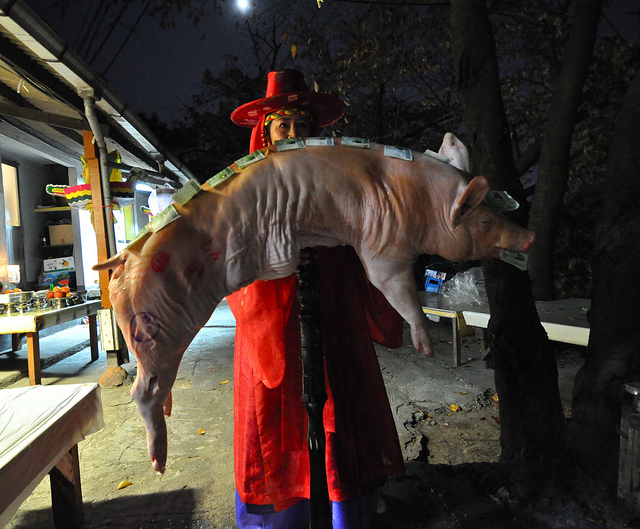[View slide show here.]
I knew things were going to get out of control when the Shaman stuck a pitchfork in the belly of the dead pig. She picked it up with the help of two other shamans. The pig was resting limp and lifeless at the top of the pole. She started chanting while the other shaman poured a huge bowl of makoli, a fermented Korean rice wine, over the back of the pig.
Next they put over $100 in bills on the pig's back. The wind blew through the dry fall leaves. Light from a full moon broke through the tree branches. More chanting ensued.
I looked over at Brian Jenkins, a buddy of mine who I'm making a short documentary about shamanism with, and he had this look of disbelief on his face. He shook his head and whispered "what?" We couldn't believe what we were seeing. It was by far one of the strangest and most amazing things I have seen in Korea, or my travels for that matter.
First Encounter
Last August I was hiking down a mountain here in Busan with friend and photographer extraordinaire Simon Bond, when we came across the shamans. They were performing some ceremony in what looked like a small Buddhist temple. They were as curious about us as we were of them. They eventually invited us in.
Before we knew it, the shaman or 'mudang' in Korean wanted us to take part in the ceremony. First, she had me pull some different colored flags from her hand. She then read my future according to the color of the flags I picked. For instance, the gold flag represents money.
Next it was Simon's turn. According to the shaman, he had the ghost of a dead relative inside him. It needed to be exorcised (see video). We were both caught off guard but couldn't believe they let us in to see the ceremony or even take part in it.
Shamanism in Korea Today
Although Shamanism was Korea's first "religion," most Korean's are not familiar with the practice. Moreover, many Korean's won't even tell their friends if they go to a shaman. When I told my Korean friends I went to a ceremony they all said they have never seen one and don't know what happens during one. However, the Koreans we met at the shaman's temple swear by them.
What I find most interesting is how shamans were an integral part of Korean society for millennium but now looked at almost like quacks and thieves by the masses. Even still, many Korean people such as politicians, businessman, the sick, and newly weds still visit shamans.
From Wikipedia:


Belief in a world inhabited by spirits is probably the oldest form of Korean religious life, dating back to prehistoric times. Shamanism has its roots in ancient, land-based cultures, dating at least as far back as 40,000 years. The shaman was known as “magician, medicine man, psychopomp, mystic and poet” (Eliade, 1974). What set him apart from other healers or priests was his ability to move at will into trance states. During a trance, the shaman’s soul left his body and travelled to other realms, where helping spirits guided him in his work. The shaman provided healing on many levels; physical, psychological and spiritual. The work of the shaman was based on the holistic model, which took into consideration, not only the whole person, but that person’s interaction with his world, both inner and outer. The soul was considered the place of life breath, where essence resided, and any physical illness was inextricably linked with sickness of the soul. Illness of the mind had to do with soul loss, intrusion, possession.Photographing the Ceremony Since then I have been to two different ceremonies. Each time we were allowed to take photos and video. The photos in the accompanying slide show are from a good luck ceremony or 'gut' in Korean. There is a woman in the photos wearing a black shirt and red vest. She came all the way from Seoul just to meet this shaman. We had her permission to take photos during the ceremony. Many of the pics are out of focus - sometimes on purpose and sometimes by accident. There was a lot of movement in these ceremonies and I wanted to convey that. At times the shamans look like mystical whirling dervishes, jumping up and down, stabbing the air with their knives and swords. Many pictures were blurred to convey that sense of motion and mysticism. On the other hand, I'm still learning about photography so some of the pics were too out of focus. Also, I had to go with a high ISO which made many of the pics even blurrier and caused some burning around the lights. I think I pushed my camera and lenses to the limit in a low-light situation, but I'm sure there is more I could learn to improve the quality. Any tips are appreciated. For More Info About Korean Shamanism Kim Soo-nam, a Korean press photographer, spent 30 years documenting Shamanistic rituals around Asia. He passed away in 2006. You can see some of his photos and read a great article about his life and work here. Dirk Schlottmann, a German ethnologist and photojournalist currently living in South Korea did is doctoral thesis on Korean shamanism. He has some fantastic photos of shamanistic rituals on Flickr. He also has three galleries (1, 2, 3) on a German website. The New York Times published a great article called Shamanism Enjoys Revival in Techo-Savvy South Korea. Finally, if you have any information about the topic please post in the comments below.
—



Recent comments